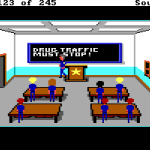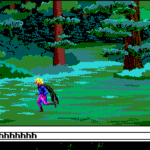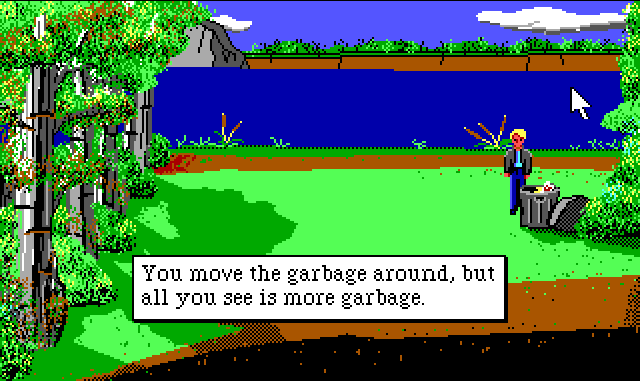
Line on Sierra: Police Quest II
March 28, 2016 - Features / Line On Sierra
After the series high so far that was King’s Quest IV, what better way to celebrate than to play another fucking Police Quest game? Guess what: I hated it!
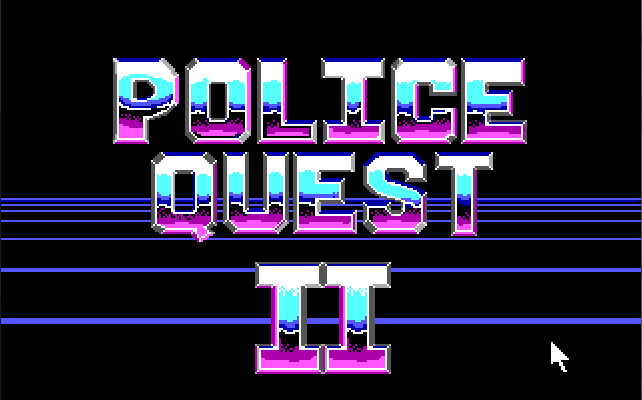
DAMMIT I forgot to hide the mouse before taking the screenshot AGAIN.
As the presence of the mouse cursor suggests, 1989’s Police Quest II uses the same Sierra Creative Interpreter (SCI0) engine first introduced by King’s Quest IV. This means some awkward optional mouse controls, much fancier graphics, and more options for things like animated cutscenes and creatively formatted text windows. Although it’s a little calmer about animating literally everything than KQIV, Police Quest II does make pretty liberal use of this visual flash in trying to sell itself as a playable cop movie, with mixed results.
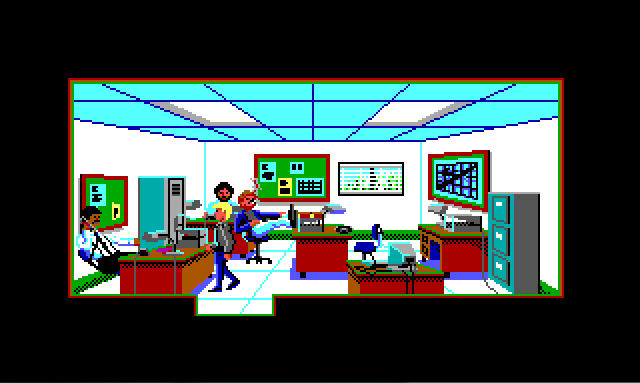
One area where PQII notably differs from other Sierra games of its time is that it more or less picks up the story of the preceding game like a normal sequel would. I have a good time pretending there’s some kind of continuity in the King’s Quest series, for example, but like, the joke is that none of those events make sense in sequence at all.
Whereas in PQII we start out with Sonny Bonds, super drugs cop, working in the narcotics office, dating his love interest from the first game, and dealing with fallout from the first game’s plot. As the game begins, we’re told that The Death Angel, the nefarious drug dealer we put away in the first game, has broken out of prison and started killing witnesses who testified against him. Okay. Again, this is not my kind of thing, but it’s a perfectly competent plot outline for a cop drama. Personally, I prefer the throw-everything-against-the-wall picaresque of your average King’s Quest or Space Quest, but I do have to acknowledge that the basic plotting in PQII is a cut above what we’ve seen so far.
Sonny also seems to have decided to keep dyeing his hair blonde, which he initially did in the first game in order to disguise himself as a pimp for some reason and oh god it’s all coming back
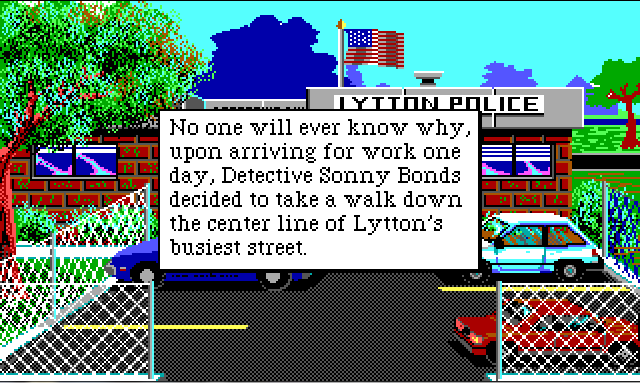
But no, no, I can do this. For YOU.
So, as discussed last time, I hate Police Quest. I hate this Police Quest for a lot of the same reasons I hated the last one. First, it’s about playing cops and robbers, and that’s in no way fun for me. Second, this installment maintains the devotion to mindless, punishing procedural rules-following that distinguished its predecessor. Time for some EXCITING COP ADVENTURES
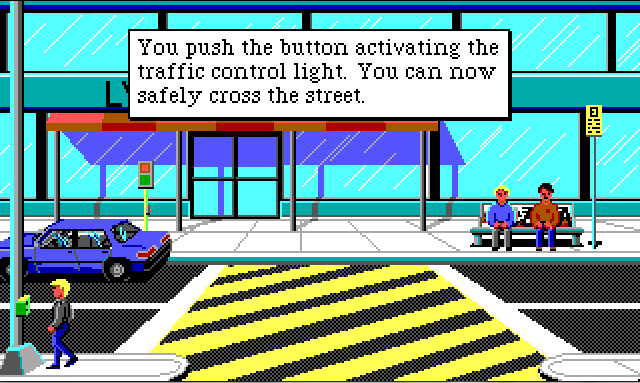
Naturally, if you don’t push this button, you die. Now, unlike Police Quest I, there seems to be a bit less emphasis on treating the manual as a reference book that must be followed to the letter in every situation. I’m guessing, because I again did not read the manual. But the instant deaths I encountered were more often the kind of thing I had at least some chance at figuring out by looking at the situation, as with this street crossing, or when I repeatedly fucked up an attempt to enter a ludicrously trapped motel room.
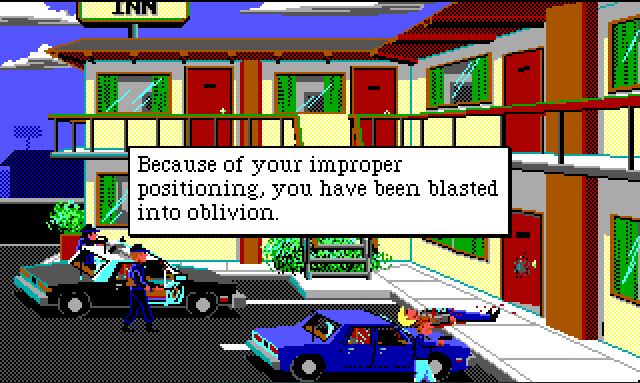
There’s a difference between this kind of thing and dying because I said things to a guy at a traffic stop in the wrong order. It’s closer to the reasons I die in Space Quest: I didn’t account for all the dangers in this situation, so the worst case scenario happened. Maybe I’m being too kind to these games by seeing this as more reasonable than straight up manual transcribing but there it is. I am perhaps TOO adapted to the Sierra house style at this point in the project.
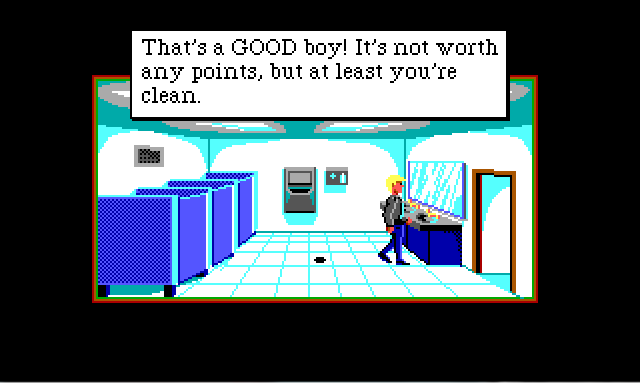
So adapted, in fact, that the interface itself makes fun of me for it. This is really something coming from Rule Following Simulator 1989. In fact, I’m pretty sure I did get points for washing my hands in Police Quest I.
But that’s not the only change the sequel has to offer! There’s also this, which very nearly made me cry tears of joy:
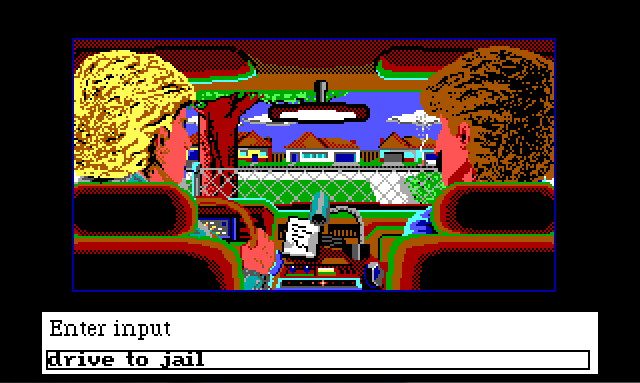
Now, instead of driving your tiny pixel car repeatedly into walls, you just type in your destination and drive there! No more “patrolling,” i.e., driving in circles and dying until you get told where to go. Sonny’s a detective now! Along with the more focused plot comes a more efficient episodic structure. Generally, after you finish up at an area, you get in the car and radio back, then receive an update that points you to the next location. Sometimes you have to head back to the station and book evidence or dick around on the computers, but it works pretty much the same way.
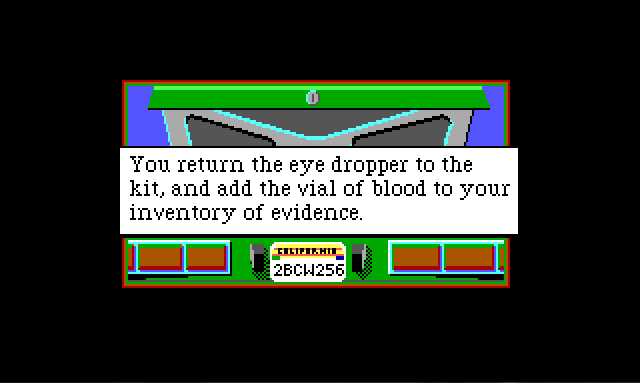
When you’re at those locations, you’re mostly doing very procedural detective stuff. This turned out to be the only part of the game that actually appealed to me, maybe because it overlaps a bit with what you might do in a murder mystery, a genre I’m much more fond of. (I also am the person who enjoyed the VR-glasses detective bits in Heavy Rain, in case you were wondering who that was.) Of course, the difference here is that there’s no mystery. You’re chasing Jessie Bains, The DEATH ANGEL, and there’s no surprises here. You repeatedly find someone who’s been murdered, then confirm that Bains murdered him by meticulously taking fingerprints and blood samples. Along the way you pick up clues that point to your next location. It’s all very routine, which is unusual for these games. I found myself getting into a rhythm, one which was almost fun.
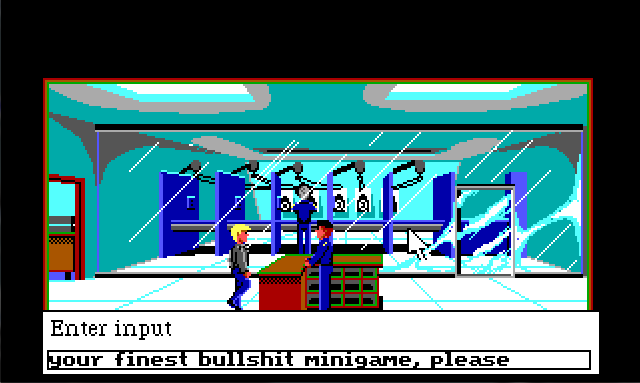
I was considerably less happy about the increased emphasis on gunplay this time around. It was obvious that this was going to be a problem when I stumbled into this big shiny shooting range while wandering the station. The shooting game turned out to be just as awkward as I’d expected. You aim the gun with the arrow keys, which move Sonny’s hands around in excruciating slow motion. Then you have to name an unmarked button precisely in order to view your target, which was exactly the moment I gave up and hit the walkthrough.
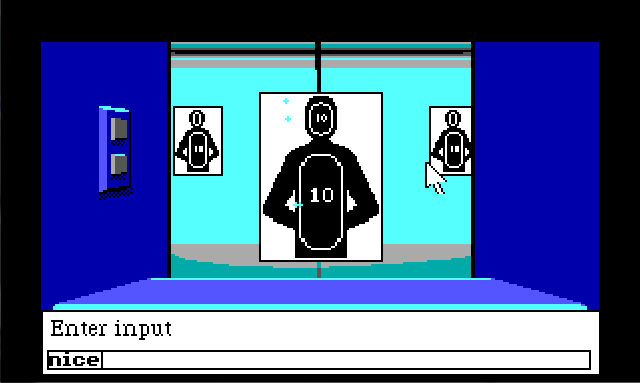
My poor performance seemed fine and great to me, and I figured I could just walk away and expect to die of incompetence at a later date. Thanks to the walkthrough being open, however, I found out that this wasn’t all I had to do here at all. Oh no.
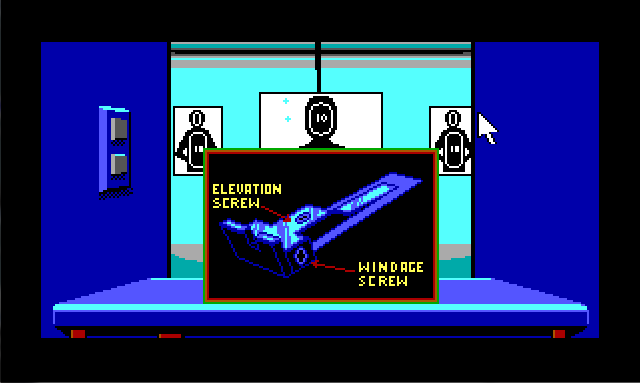
I HAVE TO FUCKING ADJUST. THE. SCREWS. ON MY FUCKING VIDEOGAME GUN. Oh, I’m sure there are some big old gun fans out there who are just over the moon about this unparalleled degree of realism. I am not a gun fan, and I say the word realism like a Ferengi says female. Maybe there’s an argument to be made for the way this focuses on the gun as a mechanical object, rather than a vector pointed at the player’s enemies, and how that’s a relatively more healthy attitude than most games with gunplay have. I’m just not the person to make that argument.
And this kinda brings me to what’s both the most interesting and most dissonant thing about Police Quest II. It’s still absolutely a Police Quest game, with the excessive procedural realism and all that. But unlike its predecessor, it’s also clearly very interested in feeling like a contemporary cop movie or TV show. I think this has something to do with the relative narrative focus I mentioned earlier, which isn’t the worst thing. But most of the time it just feels like cop movie clichés are being flung around with no context.
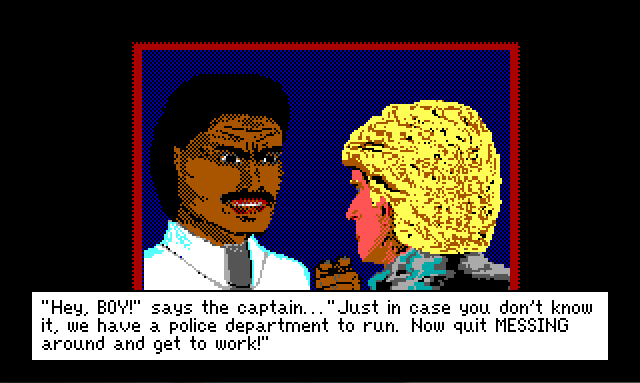
For example! Like many an 80’s cop movie, PQII introduces a modicum of diversity to its main cast by including a black police captain who’s just there to yell at the protagonist all the time. This character trope has its issues even when played straight, but it’s outright confusing here. The entire deal with Sonny is that he is not, in fact, a live wire, but rather a perfect cop who does everything exactly by the book, lest he immediately die. The “messing around” referred to in the scene above is that Sonny entered the narcotics office on his way to sitting at his desk and reading files. This character is there to add cop movie flavor, but all he did was remind me of how drastically different Sonny is from a cop movie protagonist.
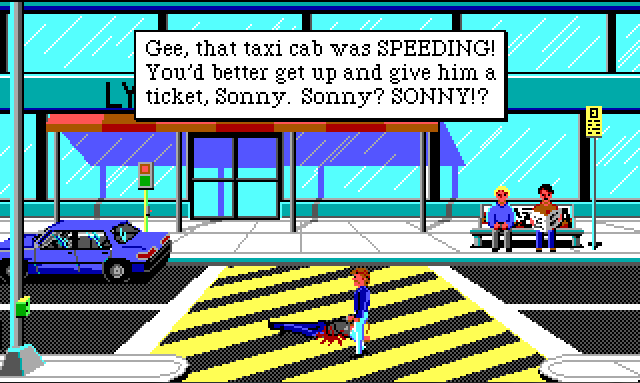
The other major new character is a similar deal. Sonny has a new partner, Keith, who is very lightly sketched as a slacker. Whenever you arrive at a crime scene, Keith vaguely says he’s going to go check something out and either vanishes or loiters around the car. This kind of works as a joke to explain why Sonny does all the work at the crime scenes (the real reason, of course, being that he’s the player character). It also sets up the expectation that Keith is going to act as a foil to Sonny’s rigid, by-the-books personality, and that by the end they’ll both come to see the value in each other’s approach. That’s the basics of buddy cop mechanics!
But none of that happens. He just hangs around the car talking about smoking nonstop.
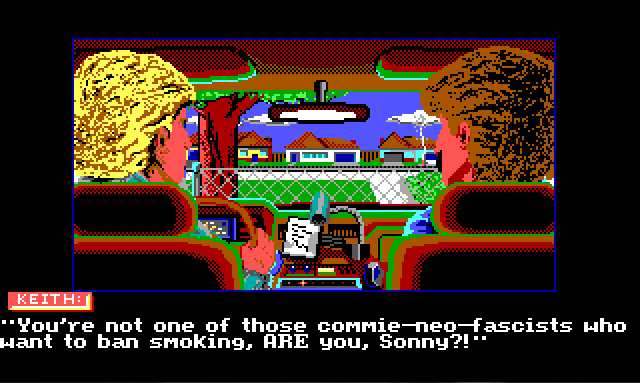
As you drive around, Keith will find one of 100 ways to ask you if it’s okay that he smokes in the car. You can say “Yes” or “NO!!!” and he responds accordingly. The introduction of a little dialogue in the car scenes isn’t a bad idea, but making it variations on the same dialogue over and over is. It is interesting to see a few steps towards incorporating dialogue into these games, which continues to be mostly unique to the Police Quest series. The car conversations with Keith are the first time I’ve seen something like roleplaying game-style branching dialogue in a Sierra game. PQII also has a phone call system, which gets used a couple times for things like getting hot dates or warning potential victims of Bains’s killing spree.

In Police Quest I, I was mostly baffled by the occasional inclusion of dialogue, because it would happen without warning. Sometimes in the middle of an exchange with an NPC, you would need to start typing in what Sonny would say instead of “TALK DRUGS” or the like. I only knew this at all because I was playing along with a walkthrough. If not, I probably would have been stuck. (Obedient players presumably picked this up from the fabled manual.) PQII is a bit better about signaling when this is going to happen, with the phone call segments being the most explicit signal that you’re now in an all-dialogue mode. That said, it’s a little frustrating that these experiments with dialogue are all happening in the series with by far the worst writing. Take it away, stereotypical Italian-American cop!
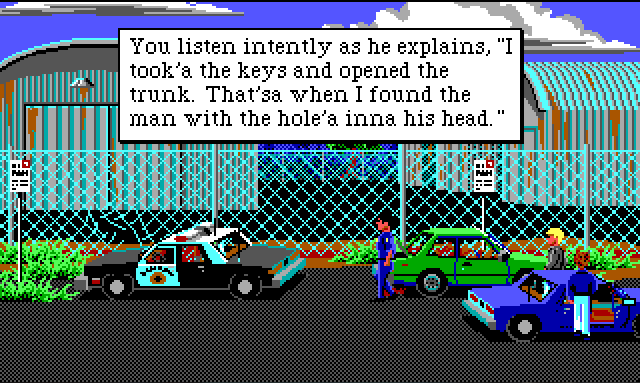
There’s just so much of this kind of thing. PQII wants to add a little unique flavor to every scene, which isn’t a bad impulse when you’re writing a naturally repetitive procedural. But in practice this means tons of NPC cops with cringey accents or other “quirky” styles of speech, jokes that make no sense, and a tone that flips from wisecracking to melodramatic with no warning. By contrast, Space Quest knows exactly what tone it’s working in; whether you like that brand of 80’s nerd scifi humor or not, the games feel more cohesive for sticking to it and doing competent work within that space. While PQII is surprisingly cohesive at the plot level, at the scene level it still very much bears the stamp of being created by an ex-cop without writing or design experience. I don’t know much about Jim Walls or what he brought to the project, but I will hazard to say that if someone was really into cop movies, but regularly got all incensed about their lack of realism, and also didn’t know how to write, that Police Quest I and II might be what that person would come up with. (Walls’s appearance in a 2013 Reddit AMA pretty much bears out this character sketch. Naturally, the AMA was about a financially shaky attempt to Kickstart a spiritual successor to Police Quest, as was all the rage in 2013.)
Early on in PQII, you get the opportunity to dick around in the police station computer by stealing your boss’s passwords (it’s fine). You can get some information on suspects, as well as the usual Easter eggs that describe other, better Sierra games you could be playing. But you can also view files on all your fellow police officers, who are all just the absolute best. Everyone’s got some kind of heroic commendation! Wow! Well, there are a couple of negative reports on the files…
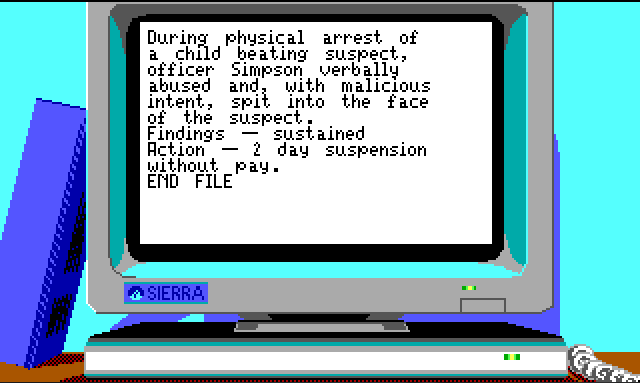
How cute. Of course none of these files suggests that one of Sonny’s fellow cops ever did anything worse than yelling too loud at a guy, and the guy in question was just so bad. In fact it’s impressive, really, that Walls’s little fictional cops restrained themselves so well! Wouldn’t you, dear player, be tempted to do worse to someone you found beating a child? This kind of self-indulgent Blue Lives Matter mythologizing sure as hell wasn’t occurring in a vacuum in 1989 California. This might be a good time to drop the spoiler that in 1993, Jim Walls left the series and was replaced by Daryl F. Gates, the former LAPD chief of police who had just resigned in disgrace following the Rodney King riots. This is almost certainly going to get worse.
There’s an implicit racism at work in the combination of these stories about perfect cops who only rarely make minor slip-ups in the heat of the moment, the fact that the suspects in the computer system are frequently listed as black or Hispanic, and the real-world context in which the game was made. But in case all that is too subtle, PQII also goes way out of its way to include an incredibly racist scene in which Sonny foils an attempted plane hijacking by a couple of vaguely Middle Eastern caricatures.
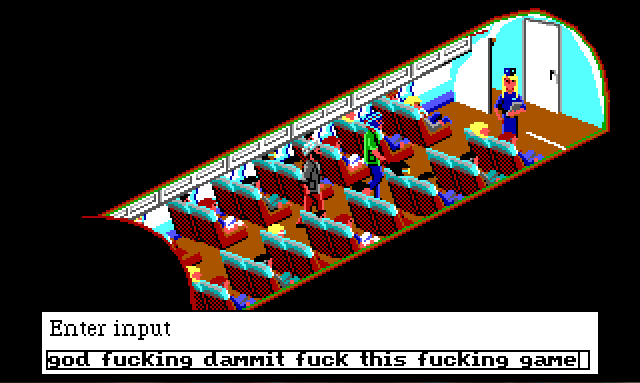
This scene is completely unrelated to the rest of the game. It’s just there to add some excitement to Sonny travelling from one city to another in search of Bains. And it’s awful. The two hijackers speak in “comical” Middle Eastern accents and represent the “Shiek of the Golden Sands” from a place called, so fucking help me, “Bum Aroun.” If played correctly, Sonny immediately shoots them both dead then searches their bodies to find the instructions he needs to defuse the bomb they planted in the bathroom. And you have to be specific about where you search them, and you specifically have to search the man’s turban to find the instructions, because isn’t that just hilarious. And then the hijackers’ bloody bodies just sit there for the rest of the flight, and when they land the local police come by and call Sonny a hero and joke about the mess. Then they take him on a helicopter ride.
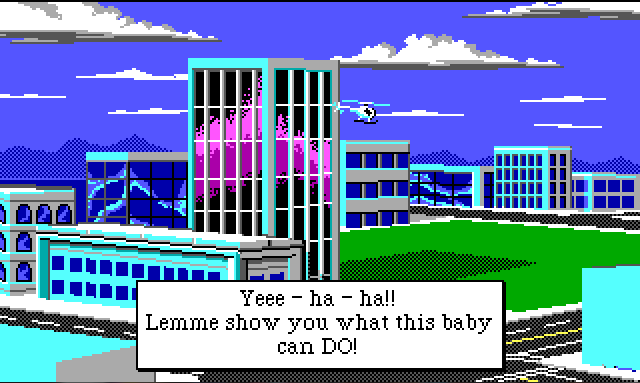
I hate this game. I hate it to hell.
Before I wrap this disaster up, I want to talk a little bit about how it handles its romance plot (i.e. poorly). Including a love interest isn’t new to Sierra adventures at this point. King’s Quest IV had a sort of romantic subplot that I found pretty weird and funny, and Police Quest I had the recurring character Marie, a sex worker and criminal informant who helped Sonny out and flirted with him a few times. A note you find in the car at the start of PQII suggests that Marie and Sonny are now dating.
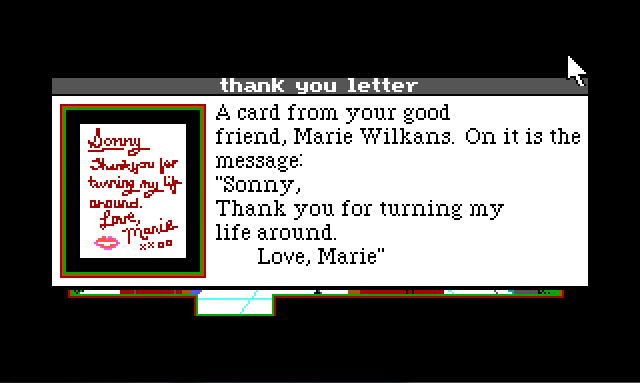
This is all fine, although I could do without the implication throughout that Sonny is some kind of savior because Marie is no longer doing sex work. It’s never made clear exactly what Marie does for work now, or what action on Sonny’s part “turned her life around.” From what I recall of the first game, all he did was get her help in infiltrating a hotel where Jessie Bains hung out, then had her testify at the trial. I guess helping the cops out removed the witch’s curse that made Marie anything other than a perfectly respectable love interest for Sonny! How convenient.
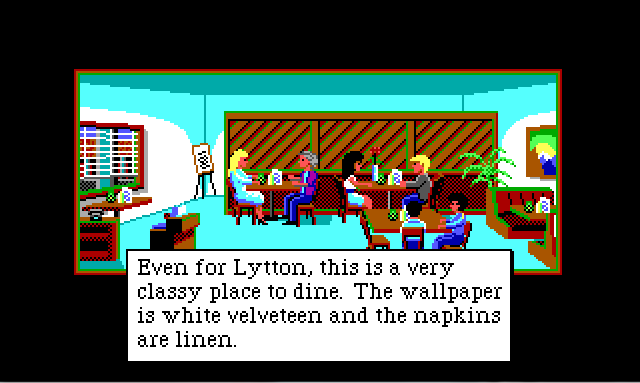
There’s a bit of effort put into integrating Marie into the game’s plot during the initial procedural bits, including a scene where Sonny and Marie go on a date after work one day. I was kind of excited to see this game’s take on dating mechanics, but the only exciting part turned out to be its description of a “very classy place to dine.” White velveteen wallpaper!! Can you imagine? Because I can’t! Other than that, it’s pretty much the diner scene from Police Quest I all over again, except that you can repeatedly kiss Marie and she keeps yelling about how great you are.
While this was an amusing interlude, its length and prominence made me suspicious. Why, after a game full of nothing but excessively detailed police work, are we suddenly relaxing and enjoying the company of our girlfriend for so long? WHY INDEED.
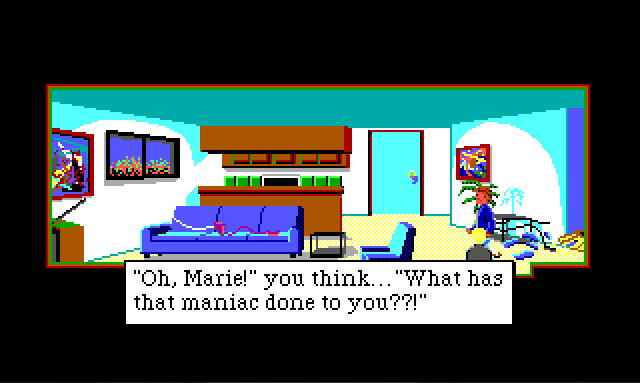
Because the next morning she immediately gets endangered by the villain, of course! Oops I’m sorry did you think that moment of focus on a woman character had any purpose other than explaining why a male character will later be upset? At least Marie doesn’t get immediately fridged; Bains has just kidnapped her so he can lure Sonny to his lair.
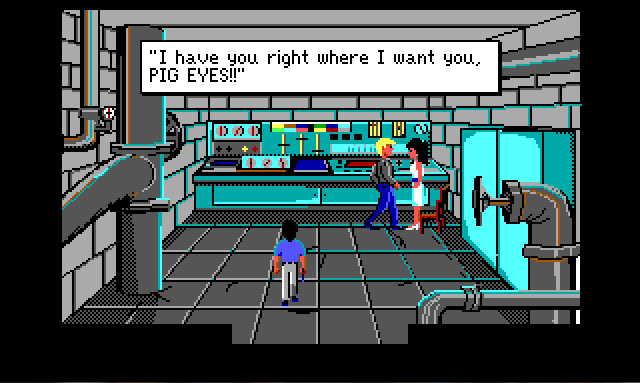
Okay, but: Bains’s lair is in another city, in a sewer hidden under a park, in a room that can only be reached by navigating an incredibly dangerous maze full of deadly gas, so his plan to lure Sonny there is actually terrible? Why not just hold Marie in a more convenient lair, with less chance of Sonny dying on the way without Bains knowing? It’s not clear what’s special about this sewer maze that getting Sonny there will make killing him more satisfying but IT’S FINE let’s move on oh wait I’m dead.
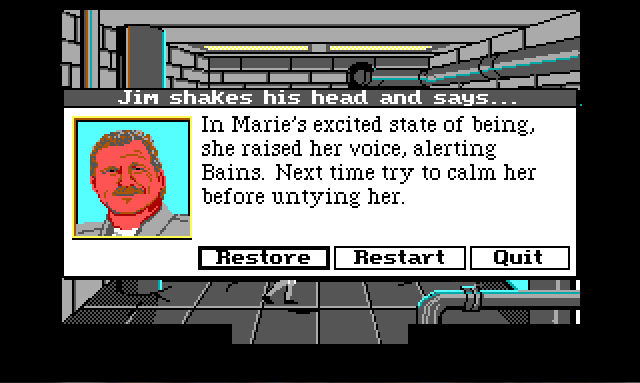
And apparently it’s all Marie’s fault! Thanks for the hot tip, Jim! Can’t let those womenfolk indulge their natural hysteria when there’s hard-boiled men with guns about! Now be a man and yell at your girlfriend to keep her safe, Sonny.
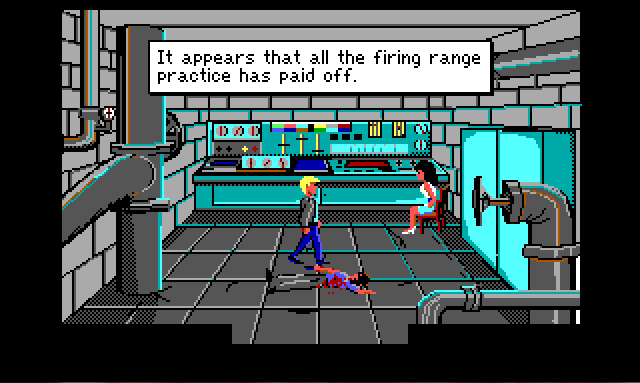
That’s right, everybody: it all came down to the screw-tightening in the end. This is actually kind of an anticlimax, since the bulk of the entire game up to this point involved gathering a ton of evidence on Bains so you could put him away By the Books. Well, now he’s just dead, oh well. Because this is Police Quest, there is an overly detailed coda in which Sonny is temporarily suspended for straight up killing a guy but eventually cleared by the investigation. It’s possible that if you don’t collect all that evidence properly, this will go poorly and you’ll get a bad end? I would love to explore that question, I really would, if this weren’t the worst game I’ve ever played to completion. As it is, I’m not going to.
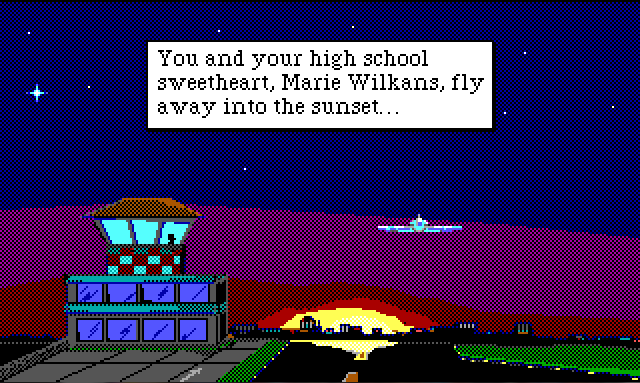
As the game ends, Sonny gets some kind of commendation, and he and Marie head off on vacation. He proposes to her on the plane during takeoff – super romantic, I know. Then, in the final moments, love works a final miracle: Marie is suddenly retconned to be Sonny’s high school sweetheart, instead of an informant he met in the course of police work. That respectable love interest magic is some powerful stuff!
Up next: thank god I can leave this trash fire behind and play Space Quest III.
THINGS THAT KILLED ME IN POLICE QUEST II: THE SURPRISINGLY MODEST POWER RANKING
- Run over by a car: 5 times
- Drowned in a river: 2
- Drowned in sewage: 2
- Shot: 2
- Methane gas: 2
- Tear gas: 1
- Improper positioning: 1
- Drinking my way through someone’s racist fantasy: 1
- The dread emotions of the human female: 1
